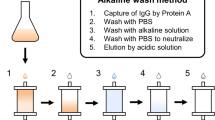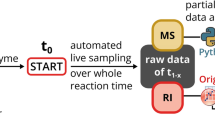Abstract
THE conversion of enzymes into water-insoluble products possessing specific catalytic activity is of interest since such ‘water-insoluble enzymes’ may readily be removed from the reaction mixture, and can be used for the preparation of columns with enzymic activity. If stable, they may be employed repeatedly to induce specific chemical changes in relatively large amounts of substrate. Adsorption techniques were applied to combine enzymes with insoluble carriers1. These procedures led, however, to partial denaturation and resulted in preparations from which the reversibly adsorbed enzyme was removed while in contact with substrate. In order to strengthen the linkage between enzyme and carrier their attachment by chemical covalent bonds seemed preferable. Such links should obviously be carried out by functional groups non-essential for enzymic activity. Furthermore, the attachment of the enzyme to the carrier by flexible polymeric side-chains would ensure free movement of the catalyst molecules in the reaction mixture.
This is a preview of subscription content, access via your institution
Access options
Subscribe to this journal
Receive 51 print issues and online access
$199.00 per year
only $3.90 per issue
Buy this article
- Purchase on Springer Link
- Instant access to full article PDF
Prices may be subject to local taxes which are calculated during checkout
Similar content being viewed by others
References
Langmuir, I., and Schaefer, V. J., J. Amer. Chem. Soc., 60, 1351 (1938). Barnett, L. B., and Bull, H. B., Biochim. Biophys. Acta, 36, 244 (1959).
Campbell, D. H., Luescher, E., and Lerman, L. S., Proc. U.S. Nat. Acad. Sci., 37, 575 (1951). Isliker, H. C., Ann. N.Y. Acad. Sci., 57, 225 (1953).
Grubhofer, N., and Schleith, L., Hoppe-Seylers Z. physiol. Chem., 297, 108 (1954).
Berger, A., Kurtz, J., Sadeh, T., Yaron, A., Arnon, R., and Lapidoth, Y., Bull. Res. Counc. of Israel, 7, A, 98 (1958).
Katchalski, E., and Sela, M., “Advances in Protein Chemistry”, 13, 243 (Acad. Press, Inc., New York, 1958).
Kay, R. E., Harris, D. C., and Entenman, C., Arch. Biochem. Biophys., 63, 14 (1956).
Waley, S. G., and Watson, J., Biochem. J., 55, 328 (1953).
Lowey, S., and Holtzer, A., Biochim. Biophys. Acta, 34, 470 (1959).
Author information
Authors and Affiliations
Rights and permissions
About this article
Cite this article
BAR-ELI, A., KATCHALSKI, E. A Water-insoluble Trypsin Derivative and its Use as a Trypsin Column. Nature 188, 856–857 (1960). https://doi.org/10.1038/188856a0
Issue Date:
DOI: https://doi.org/10.1038/188856a0
This article is cited by
-
Activity of carboxypeptidase a bound to a modified cellulosic matrix
Applied Biochemistry and Biotechnology (1987)
-
Alkaline Phosphatase insolubilized by Covalent Linkage to Porous Glass
Nature (1969)
-
Polymere Isothiocyanate zur Darstellung hochwirksamer Enzymharze
Die Naturwissenschaften (1967)
-
Chemical Coupling of Enzymes to Cross-Linked Dextran (‘Sephadex’)
Nature (1966)
-
Immunochromatographic Partition of Soluble Antigens on Columns of Insoluble Diazo-Gamma-Globulins
Nature (1964)
Comments
By submitting a comment you agree to abide by our Terms and Community Guidelines. If you find something abusive or that does not comply with our terms or guidelines please flag it as inappropriate.



